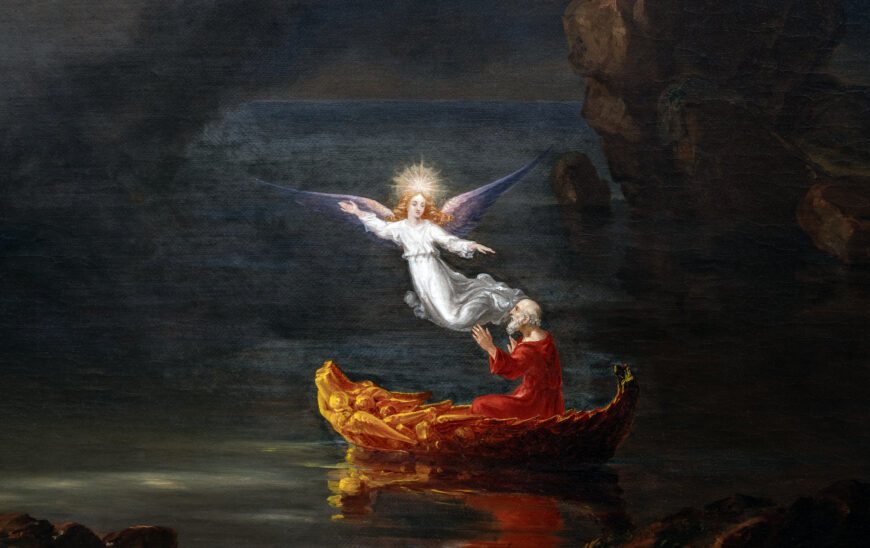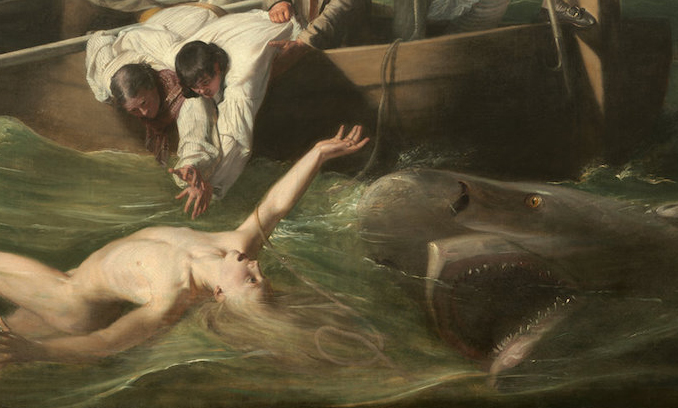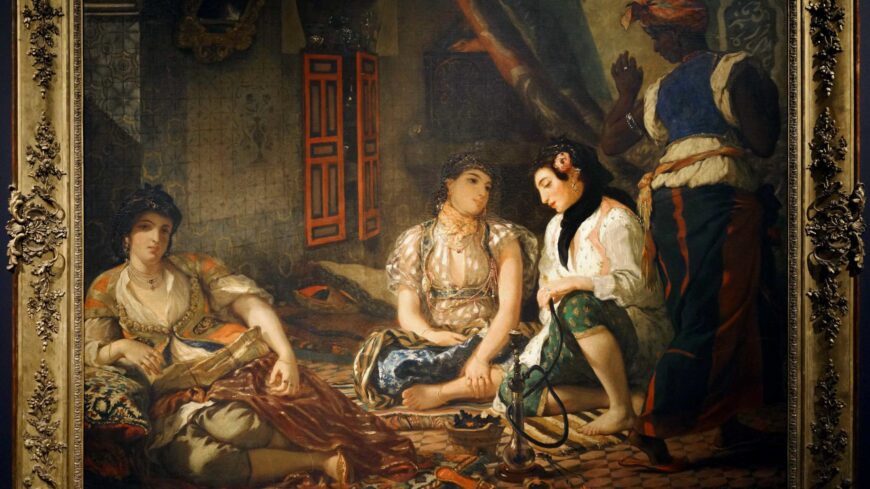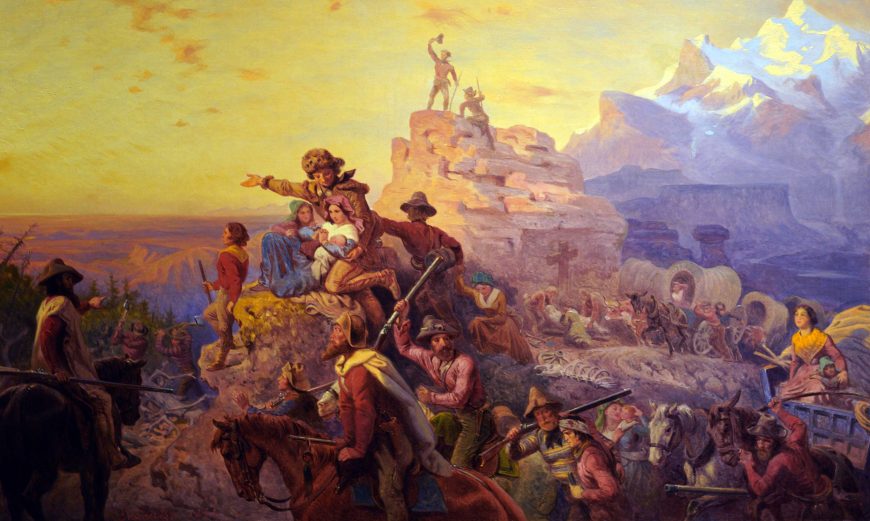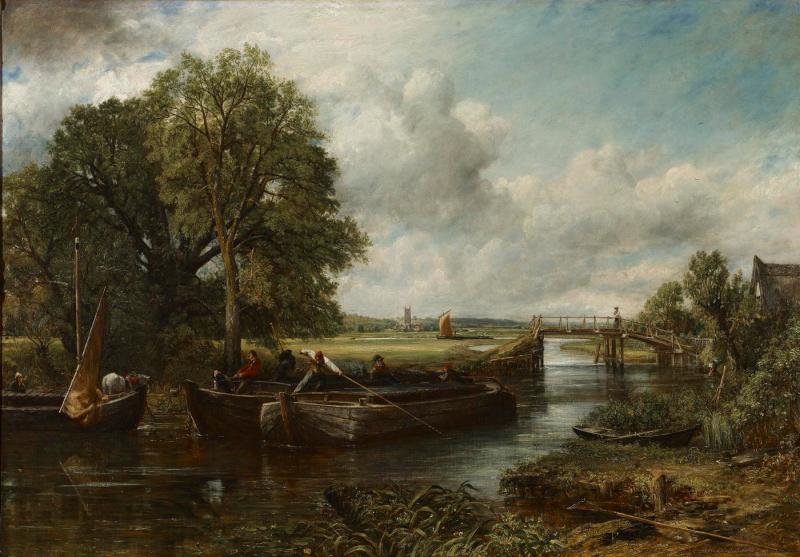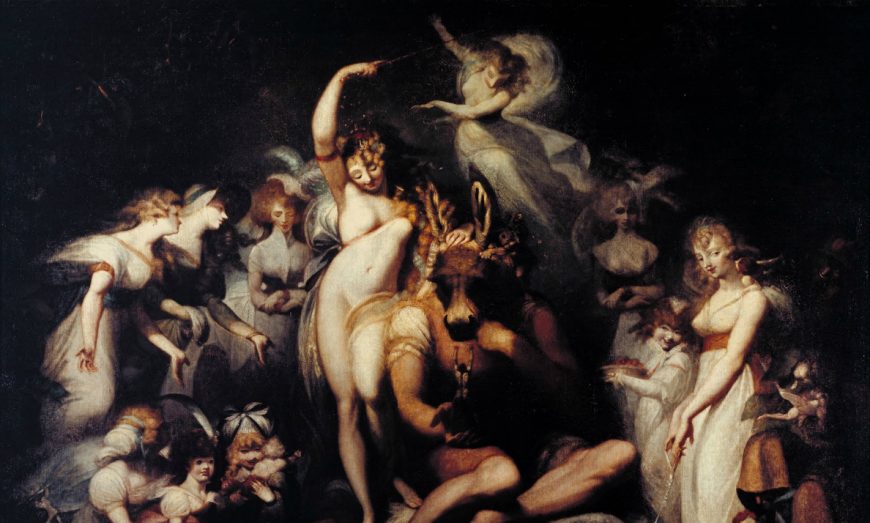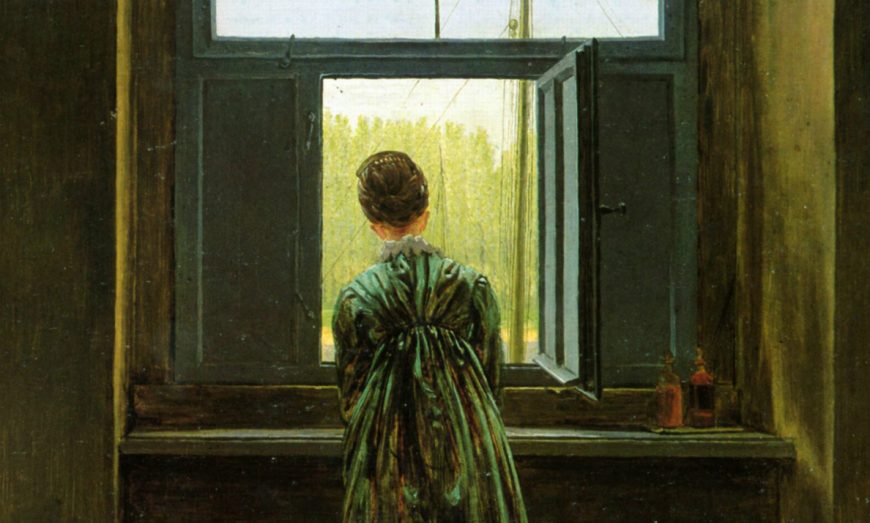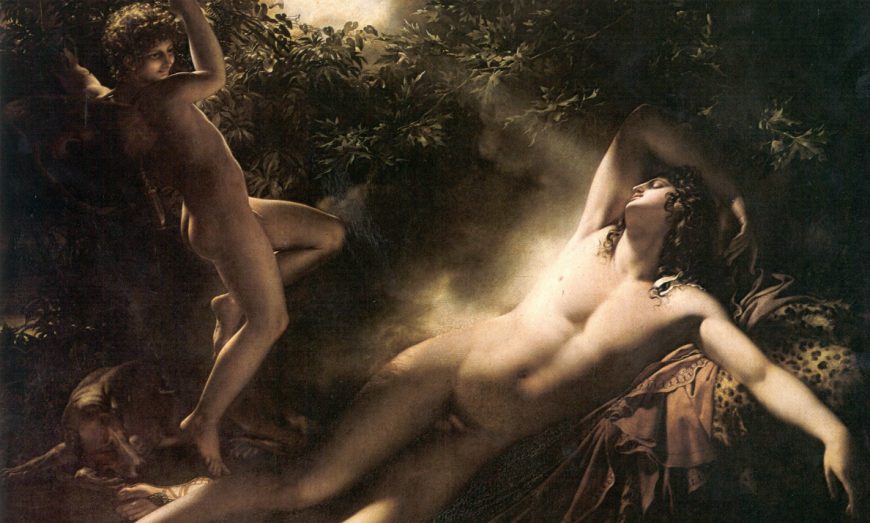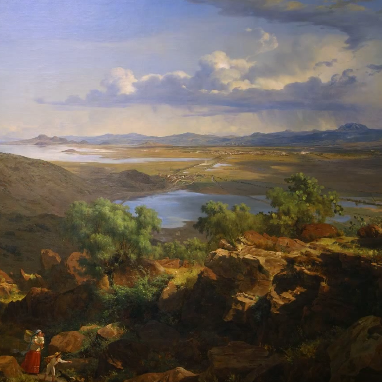Albert Bierstadt, Hetch Hetchy Valley, California, c. 1874–80, oil on canvas, 94.8 x 148.2 cm (Bequest of Laura M. Lyman, in memory of her husband Theodore Lyman, Wadsworth Atheneum Museum of Art)
Native peoples of the Plains knew the lands west of the Mississippi as their homelands, and were connected to the landscape by ancestral ties, and by sacred stories about their origins. The lands and wildlife of the West were inter- woven with their daily lives and belief systems. For Eastern Americans, on the other hand, the West was a powerful abstraction remote from their everyday experience, a vast region where dreams of a better life of wealth and opportunity might find fulfillment. From the sixteenth to the nineteenth century, the European encounter with the West was shaped by such imaginings.
John Cawelti has identified four distinct versions of the frontier myth. For some, the new trans-Mississippi frontier West reinvigorated the dreams of gold and newfound wealth that had, since the beginning, drawn Europeans to what they perceived as the New World. For others, the West offered opportunities to renew and reform a corrupt society—motivations similar to those of the seventeenth-century Protestants who migrated to New England. The West also signified escape from the burdens of a restrictive social order: unstructured by family, church, law, and school, “the territories” represented a flight from civilization. A final concept of the West rose to prominence in the period 1840-1900: the”West as America,” the idea that the process of western expansion, conquest, and settlement was the most powerful force shaping national character and identity. All four versions of the West have had a long cultural afterlife in film and fiction. None of these versions of the mythic West acknowledged the long presence of Native societies, nor that of earlier colonizers. In the mythic West, Anglo-Americans were the main actors.
From Angela L. Miller, Janet Catherine Berlo, Bryan J. Wolf, and Jennifer L. Roberts, American Encounters: Art, History, and Cultural Identity (Washington University Libraries, 2018), p. 211. CC BY-NC-SA 4.0
[0:00] [music]
Dr. Beth Harris: [0:04] We’re in the galleries at the Wadsworth Atheneum, looking at a large painting by Albert Bierstadt called “The Hetch Hetchy Valley, California.” When we think about the amazing national parks out west, we might think about Yosemite. In fact, Hetch Hetchy is within the boundaries of Yosemite. Hetch Hetchy Valley was formed by the same glaciers that formed Yosemite Valley.
Erin Monroe: [0:30] You have incredible cliffs, beautiful autumn foliage, and the Ptolemy River meandering quietly.
Dr. Harris: [0:37] But we can’t go visit it anymore and look at this same scene.
Erin: [0:42] Hetch Hetchy Valley was dammed in 1923 in order to provide water supply for the city of San Francisco.
Dr. Harris: [0:50] If we were going to go look at this now, we would see those towering granite cliffs, but where the valley is is an enormous reservoir.
Erin: [0:58] It’s been completely flooded, so all of what you see in the middle ground and in the distance is under water.
Dr. Harris: [1:05] There was a huge public outcry about this, and quite a battle between those who wanted to protect this valley, but others who felt that the need for water for the growing city of San Francisco was a priority.
Erin: [1:18] Naturalists like John Muir visited Hetch Hetchy Valley and sang its praises and soon began to fear what would happen if this dam was built.
Dr. Harris: [1:27] There was such rapid development in America throughout the 19th century, and one of the things that we see in American landscape painting is this feeling that we’re watching Americans develop the land and create industry and create wealth, but at the same time we’re watching this landscape disappear.
Erin: [1:47] Bierstadt, earlier in his career, was part of a geological survey to help reveal to Easterners what the West looked like.
Dr. Harris: [1:56] These were remote places. People on the East Coast were reading about them in newspapers and magazines and in books, but seeing a painting by Bierstadt in full color on a grand scale captured people’s imagination.
Erin: [2:11] That sense that God created nature is so important to the Hudson River School painters, but ironically was also part of Manifest Destiny and led to westward migration, which would impact the same land.
Dr. Harris: [2:26] And I think that Bierstadt does give us that sense that the West was this place that was an Eden. It was God’s cathedral. It was a place where you could escape from the turmoil of modern life.
Erin: [2:39] At the same time, the idea that this was uncharted territory was a misconception, because Indigenous peoples, Native Americans, had long lived in this area and were in fact forever impacted by westward migration.
[2:53] It’s been suggested that in the center of the painting, these puffs of smoke were part of an Indian encampment, which is possible, but at this point in the late 19th century, the area had been largely affected by the displacement of Indigenous peoples.
[3:10] Bierstadt was part of a generation that attempted to document the customs of Native Americans and what he considered to be a vanishing people.
Dr. Harris: [3:19] So here we are in the early 1870s.
Erin: [3:22] The West as an idea becomes apparent after the Civil War, where artists were aware of the increased access to the West. There was also this emerging interest in vanishing cultures, whether that was the American cowboy or Native Americans.
[3:39] The idea that the East was an area of conflict and the West was an area of promise and escape pulled strong for someone like Albert Bierstadt.
Dr. Harris: [3:47] The mountains fade back into luminous mist. There’s like softness to the forms. We’ve got detail in the foreground, specificity of leaves of trees, of moss.
Erin: [4:00] Bierstadt has a wonderful tiny inclusion on the lower left of a figure who appears to be holding a sketchbook and surveying the Hetch Hetchy Valley before him. The figure may be a stand-in for the artist, or it may be a stand-in for how the country was looking West after the Civil War.
Dr. Harris: [4:19] John Muir, when he talked about Hetch Hetchy, described it in beautiful terms. “Hetch Hetchy Valley is a grand landscape garden, one of nature’s rarest and most precious mountain temples.
[4:31] “The sublime rocks of its walls seem to glow with life, whether leaning back in repose or standing erect in thoughtful attitudes, giving welcome to storms and calms alike. Their brows in the sky, their feet set in the groves and gay flowery meadows, while birds, bees, and butterflies help the river and waterfalls to stir all the air into music.”
Erin: [4:52] Since that time, environmentalists have bemoaned the fact that this area was dammed.
Dr. Harris: [4:58] There are lot of efforts to restore Hetch Hetchy Valley, to remove the water, to allow the plants and trees to grow back. Muir did say when the battle for Hetch Hetchy was lost, “The long drawn out battle for nature’s gardens has not been thrown away.
[0:00]
“[5:15] The conscience of the whole country has been aroused from sleep; and from outrageous evil compensating good in some form must surely come.” So the idea of what could be lost was very clear in the public mind thanks to Hetch Hetchy.
[5:30] [music]


